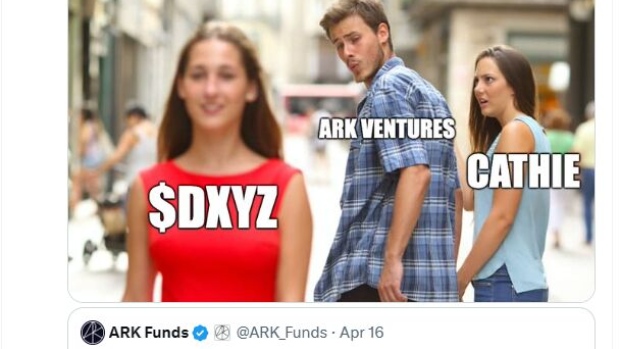Apr 18, 2024
ARK Hits Out at Destiny in Race to Open Private Assets to Masses
, Bloomberg News

(Bloomberg) -- A new Wall Street clash has broken out between Cathie Wood’s ARK Investment Management and the firm behind a young fund targeting private assets that has taken the investing world by storm.
Florida-based ARK — which offers its own vehicle focused on pre-public companies — issued an unusually candid critique of its competitor in a note this week, setting out why its product offers better access to opportunities in the private market than the Destiny Tech100 closed-end vehicle, known by its DXYZ ticker.
DXYZ’s shares have been making meme stock-like moves since its public trading debut in late March. With stakes in high-profile private businesses like Elon Musk’s SpaceX and Sam Altman’s OpenAI, it’s become a hit among the Reddit retail investor crowd, jumping to an eye-popping premium to the value of its underlying assets.
The fund “might be too good to be true,” ARK said in a post on the social platform X Tuesday. “Investors have been paying a massive premium to get access to the companies in Destiny’s portfolio.”
In emailed comments to Bloomberg News, Sohail Prasad, chief executive officer of Destiny, said he appreciated ARK’s efforts to help educate the public about how his firm was “bridging the public and private markets.” He was less subtle in his own X post, using the well-known “distracted boyfriend” meme to imply that ARK is jealous of his fund’s stellar debut.
A spokesperson for ARK didn’t immediately respond to a Bloomberg request for comment.
The exchange is a rare public show of rivalry between competing fund firms, and hints at the high-stakes race to bring the coveted world of private investing to the masses.
Read more: Bid to Bring Private Assets to Masses Fires Up Meme Crowd
The Destiny fund, which counts SpaceX as its largest holding, at one point had surged as much as 1,000% from its debut, pushing its market value to 20 times the total worth of its underlying assets. The ARK Venture Fund (ARKVX), which bears some resemblance to DXYZ with stakes in firms including Epic Games, SpaceX and OpenAI, has lost 7.5% of its value this year, trimming returns since its 2022 inception to 30%.
The difference in performance is at the heart of the debate, which stems from the products’ differing structures.
In commentary posted on ARK’s website late Wednesday, Robert Kamentsev, director of financial reporting and fund accounting for the firm, compared ARKVX and DXYZ on everything from management fees to distribution access. The basic conclusion: As an interval fund, the ARK product’s price better reflects its underlying assets, making it the superior vehicle for anyone seeking access to private companies.
But the downside of an interval fund is that investors can buy in at any time, but can only sell on a quarterly or annual basis — and there’s no guarantee they will be able to exit at those times. That’s not an issue for DXYZ, which trades on exchanges in real time, meaning investors should always be able to get out.
“An ‘interval fund’ is an example of yet another complex financial product, one we deliberately sought to avoid because we felt it was neither accessible nor liquid,” Prasad wrote. “Investors in such products risk waiting years to access their capital.”
The trade-off in the publicly listed, closed-end structure chosen by Destiny is that DXYZ shares can rally to a premium when demand is high or sink to a discount when it’s low. In other words, the price of easy access can be extreme volatility: DXYZ’s market value rose from less than $100 million to $1.1 billion in the space of eight sessions before plunging 71% over the following four days. This week, it jumped 50% in the first two days before sinking 32% Wednesday.
The fund added more than 5% as of 10:55 a.m. New York time.
“We believe liquidity matters most,” Prasad wrote. “We specifically focused on building a product that could provide access to private tech, while also having the liquidity and protections of the public markets.”
--With assistance from Katie Greifeld.
(Updates trading details in penultimate paragraph.)
©2024 Bloomberg L.P.





